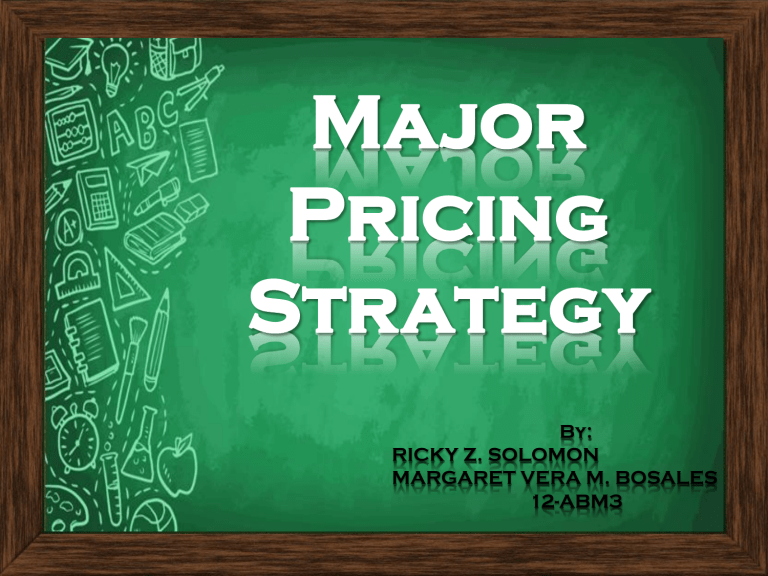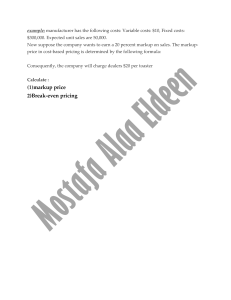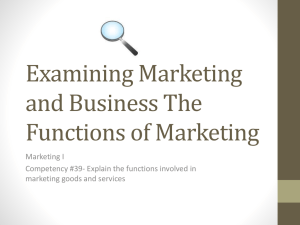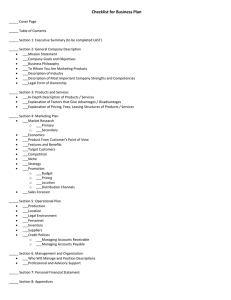
By: RICKY Z. SOLOMON MARGARET VERA M. BOSALES 12-ABM3 MAJOR PRICING STRATEGIES • The price the company charge will fall somewhere between one that is too high to produce any demand and one that is too low to produce a profit. Customer perceptions of the product’s value set the ceiling for prices. If customers perceive that the product’s price is greater than its value, they will not buy the product. • Figure 4.5 summarizes the major considerations in setting price. It suggests three (3) major pricing strategies: customer value-based pricing, cost-based pricing, and competition-based pricing. Customer perceptions of value Price ceiling No demand above this price Other internal and external considerations Product costs Competitors’ strategies and prices marketing strategy, objectives, and mix Nature of the market and demand Price floor No profits below this price FIGURE 4.5 CONSIDERATIONS IN SETTING PRICE Customer Value-Based Pricing In the end, the customer will decide whether a product’s price is right. Pricing decisions must start with customer value. When customers buy a product, they exchange something of value (the price) to get something of value (the benefits of having or using the product). Effective, customer value-based pricing involves understanding how much value consumers place on the benefits they receive from the product. Then, we have to set a price that captures this value. Customer value-based pricing uses buyers’ perceptions of value (not the seller’s cost!) as the key to pricing. Customer value-based pricing is setting price based on buyers’ perceptions of value. Therefore, the marketer cannot design a product and marketing program and afterwards set the price. Instead, price is an integral part of the marketing mix – it is determined before the marketing program is set. Cost-based pricing Design a good product Determine product costs Set price based on cost Convince buyers of product’s value • If the price turns out to be too high, the company must settle for lower mark ups or lower sales, both resulting in disappointing profits. FIGURE 4.6 VALUE-BASED PRICING VERSUS COST-BASED PRICING Value-based pricing Assess customer needs and value perception s Set target price to match customer perceived value Determin e costs that can be incurred Design product to deliver desired value at target price • Pricing begins with analyzing consumer needs and value perceptions, and the price is set to match perceived value. FIGURE 4.6 VALUE-BASED PRICING VERSUS COST-BASED PRICING Important to remember that: “Good Value” is not the same as “low price”. Companies often find it hard to measure the value customers will attach to its product. Still, consumers will use these perceived value to evaluate a product’s price. So the company must work to measure them. According to an Old Russian proverb, there are two fools in every market – • First is the one who asks too much example, if the seller charges more than the buyer’s perceived value, the company’s sales will suffer. • Second is the one who asks too little, example, if the seller charges less, its products sell very well, but they produce less revenue than they would if they priced at the level of perceived value. Two Types of Value-Based Pricing •Good-Value Pricing •Value-Added Pricing GOOD-VALUE PRICING Good-value pricing is the first customer value-based pricing strategy. It refers to offering the right combination of quality and good service at a fair price – fair in terms of the relation between price and delivered customer value. Good-value pricing is mainly used for less-expensive products, for instance for less-expensive versions of established, brand-name products. In other cases, Good value pricing has involved redesigning existing brands to offer more quality for a given price or the same quality for less. Example: •Walmart promises everyday low prices on everything it sells •McDonald’s offer value meals and peso menu items. VALUE-ADDED PRICING Value-based pricing doesn't mean simply charging what customers want to pay or setting low prices to meet competition. Instead, many companies adopt value-added pricing strategies. Rather than cutting prices to match competitors, they attach value-added features and services to differentiate their offers and thus support higher prices. •Value-based pricing in its literal sense implies basing pricing on the product benefits perceived by the customer instead of the exact cost of developing the product. •When products emotions(fashion) are sold based on •In shortages(e.g. drinks at open air festival on a hot summer day) or for complementary products (e.g. printer cartridges, headsets for cell phones) In other words, you add features and thereby customer value – and in return you charge more for the value-added product. Therefore, value-added pricing does not aim at cutting prices to match competitors, but attaching valueadded features to differentiate the products from competitors’ offers. The added value justifies a higher price in customers’ eyes. Example To return to our airlines example, take a look at higher-priced premium airlines such as Singapore Airlines, Emirates, Etihad Airways or Lufthansa. Flying with these airlines will cost you much more – but customers are willing to spend that additional price because they will get more value. Value is added in terms of comfort, luxury, premium service and so further. These additional value-added features increase the service’s value in customers’ eyes – and justify a higher price. •It’s focused on customer perception of value that your product offers, and based on the value, you determine the price, and adjust the cost. COST BASED PRICING •Setting prices based on the costs for producing, distributing and selling the product or services and adding some amount to allow the business needs to make a profit. •Goods which are very intensely traded (e.g. oil and other commodities) or which are sold to highly sophisticated customers in large markets (e.g. automotive industry are usually sold using cost-plus pricing. Example •In a retail store, a person buys something for 500 pesos and he/she sells it for 1000 pesos to customer, this is called cost-based pricing. •In other companies – such as Apple and BMW – intentionally pay higher costs so that they can claim higher prices and margins. COST-PLUS PRICING •Also known as markup pricing •Simplest pricing method •Cost plus pricing involves adding a mark up to the cost of goods and services to arrive at a selling price. Example: •Submit job bids by estimating the total project costs and adding a standard markup for profit. To illustrate markup pricing, suppose a toaster manufacturer had the following costs and expected sales: Variable cost Fixed costs Expected unit sales Php 10 Php 300 Php 50 Then the manufacturer’s cost per toaster is given by the following: Unit Cost = Variable cost + = Php 10 + = Php 16 fixed costs unit sales Php 300 Php 50 Now suppose the manufacturer wants to earn a 20 percent markup on sales. The manufacturer’s markup price is given by the following: Markup price = = Unit cost ( 1-desired return on sales) Php 16 1- .2 = Php 20 The manufacturers would charge dealers Php 20 per toaster and make a profit of Php 4 per unit. The dealers in turn, will mark up the toaster. If dealers want to earn 50 percent on the sales price, they will mark up the toaster to Php 30 ( Php 20 + 50percent of 20). This number is equivalent to a markup on cost of 10 percent (Php 20 Php 20) Using standard mark-ups to set prices generally doesn’t make sense. Any pricing method that ignores demand and competitor prices is not likely to lead to the best price. Still, markup pricing remains popular for many reasons: •First, sellers are more certain about costs than about demand. •Second, when all firms in the industry use this pricing method, prices tend to be similar, so price competition is minimized. •Third, many people feel that cost-plus pricing is fairer to both buyers and sellers. Break-Even Analysis and Target Profit Pricing •break-even pricing is called as target return pricing •shows the total cost and total revenue expected at different sales volume levels. Figure B. shows a break-even chart for the toaster manufacturer discussed here. Fixed cost are Php 300 regardless of sales volume. Variable costs are added to fixed costs to form total costs, which rise volume. The total revenue curve starts at zero and rises with each unit sold. The slope of the total revenue curve reflects the price of Php 20 per unit. The total revenue and total cost curves cross at 300 units. This is the break-even o lume. At Php 20 the company must sell at least 30 units to break even, that is, for total revenue to cover total cost. Break-even volume can be calculated using the following formula: Formula: fixed cost break-even volume = Price - variable cost Php 300 = Php 20 – Php 10 = Php 30 If the company wants to make a profit, it must sell more than 300 units at Php 20 each. Suppose the toaster manufacturer has invested Php 1000 in the business anad wants to set a price to earn a 20 percent return, or Php 200,000 . In that case , it must sell at least 500 units at Php 20 each. If the company charges a higher price, it will not need to sell as many toasters to achieve its target return. But the markets may not buy even this lower volume at the higher price. Much depends on price elasticity and competitors prices. Total revenue 1,200 Target return (Php200,000) 1,000 Total cost 800 600 400 Fixed cost 200 10 20 30 40 50 Sales volume in units (thousands) COMPETITION-BASED PRICING Competition-based pricing is a pricing method that makes use of competitors' prices, costs, and market offerings for the same or similar product as basis in setting a price. Consumers will base their judgment of a product’s value on the prices that competitors charge for similar products. In assessing competitors' pricing strategies, the company should ask several questions 1. How does the company's market offering compare with competitors' offering in terms of customer value? •If consumers perceive that the company's product or service provides greater value, the company can charge a higher price. If consumers perceive less value relative to competing products, the company must either charge a lower price or change customer perceptions to justify a higher price. 2. How strong are current competitors, and what are their current pricing strategies? • If the company faces a host of smaller competitors charging high prices relative to the value they deliver, it might charge lower prices to drive weaker competitors from the market. If the market is dominated by larger, low-price competitors, the company may decide to target unserved market niches with value-added products at higher prices. This strategy is usually implemented by companies when there are several competitors in the market selling similar products. Example • The pricing strategy used by Coca-Cola and Pepsi • No matter what price you charge – high, low, or in between – be certain to give customers superior value for that price. OTHER INTERNAL AND EXTERNAL CONSIDERATIONS AFFECTING PRICE DECISIONS In general, there is uncertainty about how consumers, competitors, resellers etc. would react to prices. Price considerations are important in market planning, analysis, marketing mix variables, demand forecasting, competitive structure, costs, and government actions. Beyond customer value perceptions, costs, and competitor strategies, the company must consider several additional internal and external factors. FACTORS AFFECTING PRICE DECISIONS Internal factors External factors •Marketing Objectives •Marketing Mix Strategy •Cost •Organizational considerations •Nature of the market and demand •Competition •Other Environmental Factors(economy, resellers and government) PRICING DECISIONS





